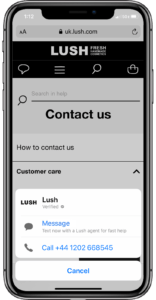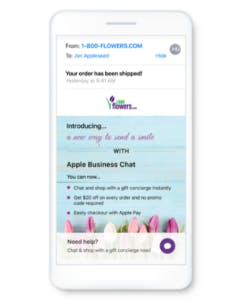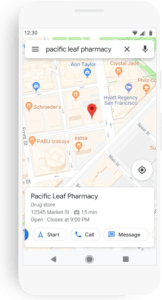How to Drive Customer Acquisition Using Apple Messages for Business and Google’s Business Messages


With iOS and Android, Apple and Google dominate the mobile operating system market, with a nearly 100% global share. If brands are looking for a way to reach new customers, going through the native apps available on virtually every smartphone in the world is a pretty good starting point.
How to Utilize Apple Messages for Business as a Customer Acquisition Tool
The number of iOS devices active worldwide is around 1.5bn. With features like Apple Pay, Apple Wallet and Augmented Reality (AR) built into the Apple Messages for Business experience , it means connecting with a brand is the same as messaging a friend. The flow is set up to be as effortless and, crucially, self-contained as possible. It’s ideal for capitalizing on the growing trend towards m-commerce transactions.
A broken customer journey is a sure-fire way to create disloyal customers, with channel switching among the biggest factors ‘breaking’ the journey. Seamless experiences which are high-touch and low effort are the key to attracting and retaining customers, and Apple Messages for Business is perhaps the best example of an uninterrupted customer journey that exists in the private messaging realm.
Three Steps to Customer Acquisition and Retention Using Apple Messages for Business
- Chat Suggest – With the option for messaging popping up on high intent web searches or Apple Maps, traffic that may have gone to a website can be deflected straight into messaging channel. Using bespoke automated flows, customers can be directed towards the product or service they are looking for

Lush uses Apple Business Chat’s tools for customer acquisition
- Pickers – whether your brand is trying to encourage customers to buy products directly or book appointments, the Pickers feature provides a really easy way to show both. There are two different functions available with the tool:
List Pickers: prompts a customer to select items to buy within the app and add them to their basket ahead of a purchase.
Time Pickers: an incredibly straightforward way to offer appointment booking – whether for a beauty business or car company looking for test drive sign-ups, customers are guided easily through the process.
From when a product is chosen, additional features such as Augmented Reality (AR) give low-effort ‘try before you buy’ CX, then payment can be made in-app via Apple Wallet. 58% of people are more likely to buy via mobile if the process is frictionless and Apple Messages for Business’s flow is so simple and uncomplicated it’s ideal for this exact purpose. - Post-purchase engagement – If a customer hasn’t interacted with your brand over Apple Messages for Business, it doesn’t mean they can’t be engaged after buying a product to help direct them towards it for the next interaction. 4/5 of consumers would like direct communication from brands post-purchase. Emails can have CTAs embedded in them, offering order tracking via Apple Messages for Business, opening up the private messaging interactions, initially with automated updates on the status of their order, which can lead to more proactive messaging and engagement such as personalized promotional offers or CSAT or NPS surveys. Mobile notifications open rates are 25x those from emails, on average, so directing to messaging as quickly and often as possible opens up real possibilities for all customer-facing brands.

How to Utilize Google’s Business Messaging as a Customer Acquisition Tool
Discovery is the key ingredient to a customer’s journey, and it always starts with a search. 3.5 billion of them every day to be exact. Google’s Business Messages gives brands the power to reach customers through Google searches and Google Maps. By their very nature, queries through both of these platforms are high intent and with Google announcing it will be removing 3rd party tracking cookies from its next version of Chrome, brands will need to look to Google’s Business Messages as a key chance for customer engagement. Without knowing where consumers hang out online, Google searches will help businesses capitalize on exactly what they are looking for.
Two Tools for Starting Google’s Business Messages Conversations With New Customers
- Google Searches or Maps – It’s a case of brands being able to meet customers at scale when they showing their highest intent for finding a business. 81% of consumers complain that it’s difficult to communicate with businesses, furthermore, after a positive communication experience, 7 out of 10 would recommend a brand to their friend afterwards. Having a direct line to a favorite brand, with an entry point via Google Maps or Search with the chance of product recommendations is how strong bonds are built from the earliest possible point. Customers are able to interact on their own terms, at the time they’re most engaged.
- PPC Ad Automation – Optimizing paid search for conversions is a marketer’s dream. As mentioned above, Google’s removal of 3rd party cookie tracking will change how brands reach customers online. PPC adverts will have much greater importance, so ensuring they convert as efficiently as possible is going to be key. With an average of 3.15% Click-through rate on PPC ads, each click really counts. Creating a bespoke automated experience for a key campaign using Google’s Business Messages rich features like image carousels to highlight products and services will increase conversion rates.

Google’s Business Messaging uses high intent searches for customer acquisition
For brands, digital customer engagement doesn’t have to be purely reactive. Rather than trying to simply run an effective customer contact center that isn’t too big a drain on your company’s balance sheet, thanks to private messaging channels, customer engagement can be a proactive revenue generator. Customer acquisition using Facebook, Google or Apple’s messaging platforms are a proven way to decrease customer acquisition cost and cost per lead on channels that have higher engagement rates than traditional channels and even other types of digital advertising. Customers are engaged in one channel seamlessly throughout their lifecycle, allowing for rich experiences that increase customer lifetime value. I’m not sure there’s a more compelling argument for utilizing the power of private messaging for driving customer acquisition.
I’ve also written a guide on how to use Facebook’s suite of messaging platforms for customer acquisition.